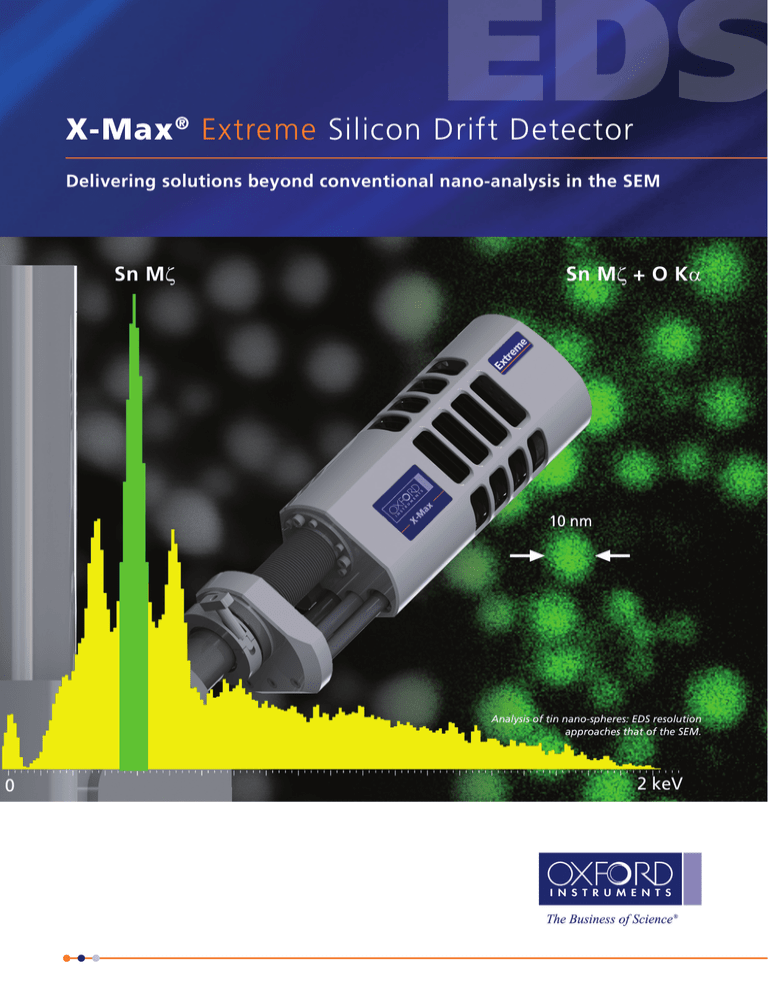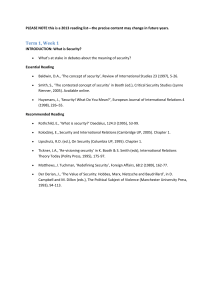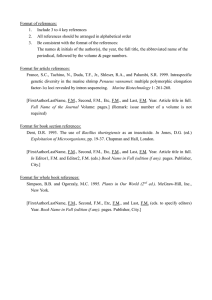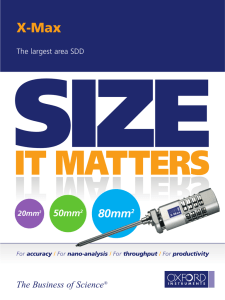
EDS
X-Max ® Extreme Silicon Drift Detector
Delivering solutions beyond conventional nano-analysis in the SEM
Sn Mz
Sn Mz + O Ka
Analysis of tin nano-spheres: EDS resolution
approaches that of the SEM.
INNOVATION
Sn Mz
X-Max Extreme
Solutions beyond conventional nanoanalysis in the FEG-SEM...
...new possibilities, better spatial resolution, more sensitivity
Sn Mz+ O Kα
In-lens SE
10 nm
10 kV
1.5 kV
In-lens BSE In-lens BSE In-lens SE 10 nm
C Kα
O Kα
B Kα
O Kα
B Kα
1 μm
0
2 keV
Analysis of tin nanosphere imaging standard: the EDS X-ray map resolution approaches that of the SEM image.
A spatial resolution and sensitivity breakthrough for EDS in the FEG-SEM
Ultra-high resolution FEG-SEMs offer
exciting new capabilities for the
investigation of smaller nano-structures,
interfaces and surfaces. However, under
the operating conditions used to make
use of new electron signal contrasts
from in-lens detectors - very short
working distance, very low kV and
minimal beam current - no traditional
SDD can provide supporting elemental
characterisation.
Until now. With X-Max Extreme, both
imaging and EDS are performed
simultaneously, while the EDS resolution
Radical new geometry maximises
sensitivity and spatial resolution in
FEG / FEB-SEM:
sensitivity conventional
• Highest
port-mounted EDS detector
• Windowless operation
15 x greater sensitivity at
• Typically
low kV than conventional large
area SDD
electronics boost sensitivity
• New
to very low energy X-rays and
extend low energy analytical
performance at higher count
rates
Tru-Q software turns
• Enhanced
the X-ray data into practical and
®
accurate elemental information
at this unrivalled spatial
resolution
shape 100 mm sensor for
• Unique
short working distance operation
2
•
Reduced footprint electron trap
configuration allows detector
operation up to 7 kV beam voltage
EDS resolution
approaches that of the
FEG-SEM
500 nm
Reducing accelerating voltage from 10 kV to 1.5 kV allows electron image contrast
to show the distribution of oxide particles. X-ray mapping under the same
conditions characterises precipitates as MnOB.
X-ray map collected at 1 kV to characterise
high-end electronic component stain
detected using In-lens SE imaging.
Sub 10 nm element
characterisation
Materials characterisation
down to 1 kV
Surface science
sensitivity
Achieving practical EDS count rates
and spectral quality at 2 kV or less,
combined with short working distance
for optimum beam size means
unrivalled spatial resolution for element
characterisation is now possible:
The latest in-lens detectors provide
new types of image contrast for new
information about nano-structures.
X-Max Extreme works at the same
collection conditions to add elemental
information to this new image
information.
At very low accelerating voltage, X-ray
information is emitted from the top few
nm or atomic layers only, making the
elemental characterisation of surfaces in
the FEG / FIB-SEM possible:
•
Practical sub 10 nm element
characterisation on real materials in
the FEG / FIB-SEM
map resolution close to SEM
• X-ray
image resolution
integrate EDS where very low
• Fully
kV electron microscopy benefits
sample characterisation
smaller nano• Characterise
structures, particles and materials
• Enhanced signal contrast
of sample damage e.g.
• Reduction
for polymers and soft coatings
bulk samples to reduce
• Use
workload on TEM and sample
charging, or achieve charge
• Reduce
balance conditions
preparation time
the composition
• Characterise
and distribution of surface
contaminants and layers a few
atoms thick
characterisation of
• Integrate
surfaces with SEM investigation
the surface structures only
• Analyse
visible with in-lens detectors at very
low kV and short working distance
money and time compared to
• Save
Auger / XPS
approaches that of the SEM itself.
2 X-Max Extreme
X-Max Extreme 3
LITHIUM
X-Max Extreme
Pioneering nano-characterisation solutions
Li Kα
1 μm
Spectrum collected from Li2S showing very low energy
Li K and S L lines. Data courtesy Hydro Quebec.
Li K X-ray map showing corrosion of
Li metal to LiOH and Li2CO3.
Fastest and most accurate
nano-characterisation
Extreme light element
sensitivity
Lithium detection and
mapping
X-Max Extreme collects more and
better quality EDS data at higher spatial
resolution. With the AZtec Tru-Q®
processing engine, this provides the
fastest, most accurate characterisation
possible in the FEG / FIB-SEM.
The windowless configuration and ultra
high sensitivity of X-Max Extreme
offers the most sensitive light element
detection.
Oxford Instruments announced the
first successful detection of Li X-rays by
EDS in 2012. We have developed this
know-how adding new ultra low noise
electronics for the detection of X-rays
below 100 eV.
• High speed collection
low energy spectrum
• Unrivalled
quality and integrity
• Real-time data processing
autoID and TruMap peak
• Rapid
overlap correction of low energy
X-ray lines
to 15 x increase in signal over
• Up
conventional detectors
at lower kV to minimise
• Work
sample damage and charging
potential for the detection
• New
and characterisation of difficult
detection and X-ray mapping
• First
of Li Ka (only 56 eV)
detection of lithium in
• First
compounds e.g. LiH, Li N, Li O, Li S,
elements, such as nitrogen
LiF and LiCl by EDS
3
2
First characterisation of materials
ability to analyse polymers and •
• New
using Si L, Al L and Mg L lines
soft biological materials
www.oxford-instruments.com/extreme
The materials presented here are summary in nature, subject to change, and intended for general information only.
Additional details are available. Oxford Instruments NanoAnalysis is certified to ISO9001, ISO14001 and OHSAS
18001. X-Max and AZtec are a Registered Trademarks of Oxford Instruments plc, all other trademarks acknowledged.
© Oxford Instruments plc, 2016. All rights reserved. Document reference: OINA/X-MaxExtreme/0116.
2




